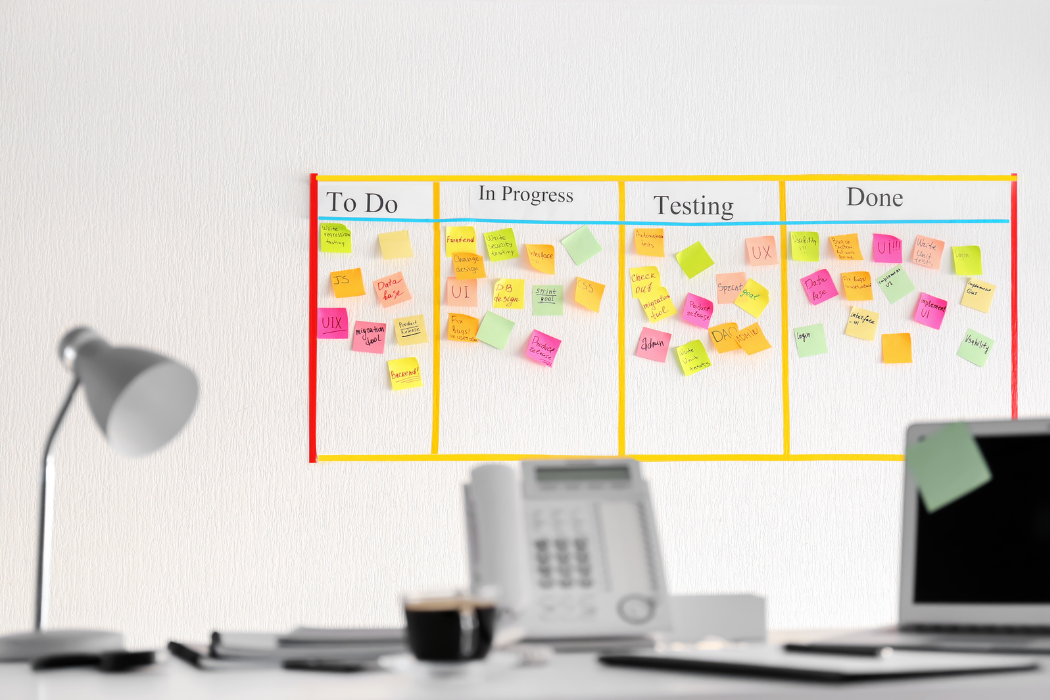Distributed Scrum Team – Scrum is a methodology for Agile software development that has proven effective for managing projects with several developers. Remote teams may also benefit from this framework, but they will need to make some adjustments to their processes in order to achieve their goals.
With this article, we want to help you better manage a remote Scrum team. We also detail the Scrum event management process, which may be used to quickly document issues and brainstorm.

What Is A Distributed Scrum Team?
A distributed scrum team is a scrum team that works remotely, either entirely or in part. A distributed scrum team needs innovative methods of implementing scrum in order to achieve its goals. Because of limitations on ad hoc cooperation and informal communication, remote teams need to be stricter about their scrum routines and develop new possibilities for bonding and collaboration.
The good news is that many of the scrum frameworks are established rituals, tools, and responsibilities, including sprints, ceremonies, daily scrums (also known as stand-ups), and retrospectives, and can be adaptable to a remote workplace setting.
Standard agile teams should adhere to the two pizza rule which states that the team size should be no more than 10. However, smaller teams are preferable while working remotely. This is because it is far simpler to run a virtual meeting with five or six individuals than ten. With a distributed team, the classic scrum roles are still essential but must be changed to adapt to the particular difficulties of remote work.
Benefits of Distributed Scrum Team
Scrum with distributed teams may draw from a wider pool of qualified candidates, resulting in more diverse skill sets. There are many opportunities to hire excellent Developers since members of the Scrum Team can be anywhere in the world.
Members from various areas may contribute a wealth of knowledge that can benefit the globe, including varied perspectives, working methods, values, and even technological advances.
Distributed Scrum Teams may operate around the clock since their members are in different time zones.
Because of its worldwide reach, Scrum with remote teams produces the highest quality self-managing, cross-functional Agile teams.
Scrum has been a lifesaver to the many enterprises that have gone remote because of the COVID outbreak. It is a method for facilitating efficient and worldwide collaboration via the use of a shared set of tools and practices. The teams can be more agile and keep evolving thanks to their flexibility and adaptability to user requirements. According to Gartner, “Remote teams that follow Agile technical practices can outshine or outperform a colocated team which does not follow Agile practices”.
Challenges That Distributed Scrum Team Might Face
Agile software development was designed for groups working together in the same building. According to the 2001 Agile Manifesto, “the most efficient and effective method of conveying information to and within a development team is face-to-face conversation”. It’s been a long time since 2001, yet a lot has happened in that time. Collaborative tools like Zoom, Slack, Jira, Confluence, and Trello have made it easier for distributed teams to work together. Zoom has done a fantastic job of bringing agile to remote employees and remote meetings for individuals and teams.
Also, the requirements of the globe have shifted. Because of the global distribution of skilled workers, it is unrealistic to expect that everyone will be in the same location at all times. It’s a common misconception that teams working apart from one another can’t achieve that much. Although this may seem surprising, multiple studies have shown that remote teams are typically more productive than in-person teams because they face fewer interruptions.
Communication issues are a major barrier for remote scrum teams. Team members working remotely have to communicate more and, at times, over-communicate to make up for the lack of casual hallway discussions and unplanned in-person meetings. Video conference calls need special consideration for different time zones.
There may be a decline in team spirit and a need for social interactions among coworkers. Creating a feeling of teamwork among remote workers might be more difficult as well.
Last but not least, it is more difficult for remote teams to share information, which may lead to misunderstandings, especially when team members are in diverse time zones. Coordination of a project may be complex or time-consuming if the product backlog is fluid or poorly defined.
How to Manage a Distributed Scrum Team
Depending on the context, a Scrum team may be entirely or partly distributed across different locations. The team can use online collaboration tools to monitor problems, send messages, perform ceremonies and brainstorming sessions, which is the primary distinction from the in-house team, which has meetings next to a real whiteboard. Scrum ceremonies, as well as most of the rest of Scrum’s specified set of rituals and responsibilities, may be adapted to a remote work setting.
Consistent and well-organized meetings ensure that everyone in the dispersed Scrum team is on the same page, and that the product owner receives timely feedback from all team members. Most importantly, this means holding daily standups to find out whether there are any problems or roadblocks stopping anybody on the team from accomplishing their goals.

When supervising a completely or partly remote Agile team, keep in mind the following:
1. The limit for daily stand-up is 15-minute
The Scrum Master’s responsibility is to keep the daily stand-ups concise. If a team member is providing status, no one else should interrupt them. If there is anything that needs more time than the daily stand-up allows for, the relevant team members should schedule an additional call. The Scrum Master should also make sure that these kinds of discussions take place afterward.
2. Teams operating in separate time zones may benefit from asynchronous stand-ups
Asynchronous meetings allow members of a globally distributed team to connect through Slack, share meeting notes, and get feedback from others. The use of Zoom will be less stressful as a result.
Everyone on the team may send in a status update before the daily stand-up if they want to.
3. Tracking sprint progress on online Scrum boards increases transparency
During a sprint, the team should organize their work via a platform like Trello or Jira. The Scrum Master is in charge of keeping the board up-to-date when work is performed. There should be a clear visual of the team’s progress throughout each sprint from the task list. That way, everyone is on the same page and knows exactly what has to be done to finish a project (and when it will be ready).
4. Decide a means of communication and make sure the distributed Scrum team is on the same page
The Scrum Master’s job is to clarify the purpose of each channel in the Slack workplace. Teams should use less time-consuming communication channels like email or problem trackers before resorting to chat. Getting people’s attention when you need it will be easier if you don’t interrupt them quite so much.
In every other way, leading a remote Scrum team is the same as leading a local one. The Scrum Master is in charge of the sprint planning, works closely with the product owner to create a product backlog, and protects the team from any outside stakeholders that seek to increase the project’s scope.
Scrum Events and Remote Management
Scrum events are held often to help teams better communicate and work together, respond quickly to changing circumstances, and change their work as needed.
Scrum is not about burdening engineers with mountains of paperwork, but rather about having more productive discussions and bringing immediate attention to pressing problems. Here we will explore the core Scrum team meetings and how to run them effectively.
1. Sprint Planning
The purpose of the sprint planning meeting is to establish a shared understanding of the sprint objective and the direction for the team’s work over the following weeks. It encourages the team to look at their work often, find the most strategic one, and finish it.
- Discussion at the sprint planning meeting often falls under two categories:
- What should be developed during the sprint?
- How the team will build it?
A Scrum Master can keep everyone on track with Agile methodology and let programmers choose which user stories to work on throughout the sprint. Let’s break down the project into its component parts and see who’s responsible for the problems in each.
a. What should be developed during the sprint?
The product owner usually gives story overviews. Explaining the purpose of the sprint is their responsibility.
Before beginning a sprint, a team will often agree on the goals they will focus on. Team members query the product owner to clarify the scope of the work, then prioritize tasks for inclusion in the current sprint. Before the sprint planning meeting, the team may also assist the product owner in refining and prioritizing the project backlog.
b.How the distributed scrum team will build it?
Developers take the lead during this phase as they plan out the specifics of delivering the prioritized product backlog items. Tasks for completing user stories may be divided down into design, coding/implementation, research, and QA areas.
The sprint plan is the result of the sprint planning meeting and is reviewed on a daily basis as part of Scrum.
2. Daily Stand-up (Daily Scrum)
According to the Scrum Guide, the daily stand-up helps teams become organized and stay on task. It generates a workable strategy for the next day and focuses on making progress toward the sprint target. The truth is that daily Scrum meetings aim to:
- Identify Blockers,
- Discuss Difficulties,
- Request Assistance,
- and Distribute Useful Data
It’s possible to use asynchronous stand-ups if your distributed team doesn’t have overlapping work hours. They can share updates by creating a separate Slack channel or writing on their work board.
It is the Scrum Master’s responsibility to ensure the efficiency of daily video calls if the remote team opts to implement them. Rephrasing work updates that are already visible on the work board serves no use. Moreover, there are situations when developers go too far into debating technical implementations or issue remedies.
The rest of the team who aren’t familiar with the feature or technical stack will likely tune out within the first 30 seconds, and they won’t come back until the conversation has moved on to something else, or until the team has moved on to a different developer.

3. Sprint Review
The product owner discusses the current status of the product with stakeholders (such as product managers, designers, and business analysts), receives input, updates the product backlog based on that feedback, and accounts for budgetary and market shifts at the sprint review.
The sprint review typically consists of two parts:
- Check on the “Done” and “Not done” statuses and show off your progress. Producing applications for smartphones, for instance, necessitates providing all attendees with smartphones on which to test them. The most recent build of the app should be installed on these phones so that stakeholders may test out enhancements.
- Work with the client to see whether the work you did solve their issue, talk about how the market or their plans for the product have evolved, and figure out what comes next.
During the refining phase, it is more vital to listen to comments from stakeholders than to display the individual efforts of team members.
4. Sprint Retrospective
In contrast to the sprint review, where the focus is on increasing product value, the sprint retrospective provides a chance for the scrum team to get together and work out any issues that have arisen throughout the sprint. The team discusses the interactions between team members, as well as the tools and development techniques, to determine what worked well and what may be improved for the next sprint.
Stakeholders may choose to attend retrospectives or at least see the notes afterward in order to have a better understanding of the team’s perspective on the areas that need improvement.
The Scrum Master’s role in this sort of gathering is to foster an environment of trust and gratitude. This is not a place to assign blame, but rather to draw inferences, make adjustments, and take steps forward as a team. The goal is to improve with each Sprint, and this forum may help with that.
Scrum Masters often follow the five steps outlined in “Agile Retrospectives” during retrospective meetings:
1. Set the stage
Give people time to “arrive” and get them ready to participate.
2. Gather data
Create a shared pool of information to make sure people are working with the same set of facts.
3. Generate insight
Why did things happen the way they did? Identify patterns to see the big picture.
4. Decide what to do
Pick a few issues to work on and create action plans of how you’ll address them.
5. Close the Retrospective
Clarify the follow-up and express appreciation.
The information-gathering and analysis stages will likely be the most challenging. The Scrum Master might benefit from learning more about data collection and analysis. It’s best to begin with a broad range of inquiries, such as the following:
- Who gives a hoot about this problem, anyway?
- Can any additional consequences be seen?
- How does this problem affect specific individuals or communities?
- In which way would this affect our company?
…before delving into further depth and specificity:
- When do you see the issue arising?
- Which time does it happen and how often does it happen?
- What possible causes may there be for this issue?
- Is there anything else that might change the situation?
- Do such occurrences usually occur, or was this an unusual case?
- If the Scrum Master anticipates several problems, it is preferable to have individual meetings to address each one.
Retrospective sessions not only lead to a solution but also urge the participants to reflect and learn; nonetheless, certain situations may need extra coaching or more in-depth training.
5. Backlog Refinement
Even while the product owner and development team could kick off backlog refinement with a formal meeting, it’s often a continuous process where details, assessments, and ordering of user stories are added.
The product owner and product team may stay on the same page with the aid of backlog refinement. Its primary goals are to:
1. Set priorities clearly for the distributed scrum team
The group will prioritize the right things and think forward at least two Sprints.
2. Keep up the pace of a sprint.
The team should already have well-defined tasks that are ready to be added to the sprint backlog before the sprint planning meeting ever begins. Because of this, no time is wasted on further consideration or preparation.
3. Run effective meetings
Since the items in the backlog have already been analyzed and prioritized, the sprint planning process is quick and open to everyone involved.
Teams may take the initiative to make adjustments if they lack product vision or are unsure of the nuances of a feature’s operation. The Scrum Master should also attend these sessions so that they may get an understanding of the state of the sprint’s objectives. They will use the information gleaned from the retrospective to guide the team in setting realistic goals for the next iteration.
However, even if the quality assurance team operates independently and follows its own set of rules, it is still preferable to include them in the refining process. The development and quality assurance teams will be more in sync as a result.
Primary steps in the refining process include:
- classifying outstanding tasks by how soon they need to be completed and how far in the future they can wait;
- drafting up brand-new user narratives to accommodate unanticipated requirements;
- breaking down user stories into more manageable chunks;
- making or adjusting estimates;
- deleting stuff that doesn’t seem to be relevant;
- problem tracking: closing issues outside of the team’s long-term capabilities and marking them as “out of scope” for future investigation;
- shifts in priorities as a result of new information, such as consumer comments, feature requests, or cost breakdowns.
Key Takeaways For Your Distributed Scrum Team
When the epidemic hit, everyone had to work from home, thus remote Scrum Teams became the norm. If the Team adopted the remote principles, they could more easily collaborate across locations. This enables the team to build an Agile culture throughout the whole company.
The team’s success in their projects and the company’s overall growth would benefit from having well-defined processes, procedures, tools, and methodologies for working at scale. Managing a remote Scrum Team may seem impossible, but any remote team can be successful with the appropriate tools and devotion to Scrum’s remote principles.
Visit Innotech Blog for more insights from industry experts.


